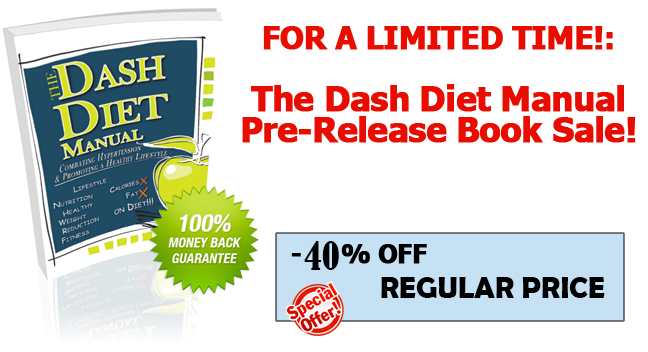How To Lower High Blood Pressure: The Ultimate Guide
21 Easy Things You Can Do Today To Lower High Blood Pressure Fast and Naturally
High blood pressure happens for a number of reasons. It can be due to your lifestyle, genetics, diet, or the products you use.
However, in spite of the huge diversity of causes, high blood pressure can be treated – fast and naturally.
Actually, there are several ways available for you to perform in order to end your health’s misery.
In this ultimate guide we show you not just a single method, but 21 of the best approaches to lower high blood pressure for good.
Nutrition and Diets
This perhaps isn’t the first time you learn about the relationship between diet and blood pressure. In any case, it’s one of most considered causes of high blood pressure. And it remains an ongoing task as specialists are strong-minded to establish more studies. But what puts specialists to point fingers on food? Now, we are about to find out.
1. Follow the DASH diet
If you’ve been frequently browsing for an answer for your high blood pressure, there’s a high chance you’ve come across the DASH diet in your search.
This should really be a standard topic among hypertension sufferers who are finding ways to lower high blood pressure.
The DASH diet can sound overwhelming, or even too methodical initially; but what it basically means is reducing sodium intake and taking food items that can lower high blood pressure.
DASH stands for Dietary Approaches to Stop Hypertension. It is recommended by: The National Heart, Lung, and Blood Institute; and The American Heart Association.
In fact, the diet is in line with dietary recommendations to prevent stroke, heart disease, cancer, diabetes, and osteoporosis. It has also shown effective results with weight loss and long-term weight management.
Low-fat dairy foods, vegetables, fruits, and whole grains are among the top DASH diet food requirements.
What Is The DASH Pyramid?
The DASH Pyramid is a guide, which clearly indicates the food types (choose low-salt foods) to eat daily in specific serving amounts for a 2000-calorie-a-day diet. It is carefully designed to reduce total fat, saturated fat, and cholesterol to substantially lower low-density lipoprotein cholesterol and high blood pressure. Following the DASH diet, you can see significant results in only two weeks. In fact, it is the #1 Best Diet Overall according to US News & World Report.
Food items that belongs to the foundation of the pyramid are fruits and vegetables. Whole grains are at level two. Both meats and low-fat dairy share level three, with poultry and fish taking priority. The fourth level comprises seeds, legumes, nuts, and oils for healthy fats. Sweets are at the top of the pyramid but should only be taken at 5 or less servings in a week.
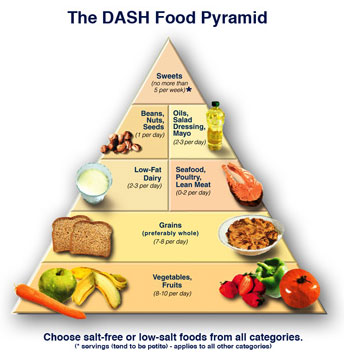
How’s DASH Pyramid related to your blood pressure?
When you eat a certain food high in sodium, saturated fat, trans fats, and cholesterol, it causes your blood pressure to increase. Unhealthy fats can build up on the wall of your arteries causing a narrowing which results to elevated blood pressure. This increases your risk for a stroke or heart attack.
Trans fatty acids, in case you’re curious, is the most unhealthy type of fat. It increases LDL “bad” cholesterol and decreases HDL “good” cholesterol. Also, it can promote systemic inflammation further increasing your risk for cardiovascular diseases. And when there’s much bad cholesterol, there’s (you guessed it right!) high blood pressure.
Aside from causing inflammation, trans fats can also increase triglycerides in your bloodstream. Normally, these are converted calories stored in fat cells. But an increase in triglyceride can contribute to thickening of arterial walls and hardening of arteries.
But what about DASH diet foods?
Well, studies point out that following the DASH diet can improve blood pressure naturally. The DASH-Sodium study, in case you haven’t heard of it yet, is a great example of this.
- The study involved 412 adult participants with systolic blood pressures of 120 to 160 mmHg and diastolic blood pressures of 80 to 95 mmHg. Participants were divided into two groups who either followed the DASH diet or the typical American diet for 3 months.
- Upon detailed analysis, not a single person who followed the DASH diet with reduced sodium intake has NOT shown a significant decrease in blood pressure- even those over the age of 45. Greater reductions were observed in individuals with high blood pressure than those with normal blood pressure.
When replacing high calorie foods with fruits and vegetables, it can lower a meal’s caloric content. This is because fruits and vegetables are naturally low calorie nutrient dense foods.
Best example to this is adding ½-cup serving of spinach and ½-cup serving of carrots to replace 3 ounces of meat instead of 6 ounces in a hamburger. You’ll be able to save 200 calories.
To start with the DASH diet, here are some of the zero-calorie food items you may want to consider in your healthy quest:

Credits: YOURWEIGHTLOSSAID.COM
2. Limit your intake of sodium
Sodium is widely known to increase blood pressure. There are several studies to back this up. An increase in sodium in the bloodstream causes an imbalance and reduces the ability of the body to regulate fluid excretion.
Apparently, it’s common to salt-sensitive individuals which puts them at higher risk of becoming hypertensive. Take for example African-Americans.
Salt-sensitivity has been found to be so prevalent in 73% of hypertensive African-Americans than Caucasians that it’s been considered a hallmark for hypertension. Only a half of the general population with high blood pressure seem to have sensitivity to salt.
In fact, the American Heart Association dietary guidelines recommend a 2300mg to 1500mg daily sodium intake limit depending on your situation. A small reduction in sodium intake can lower blood pressure by 2 to 8 mm Hg.
But what about the use of salt substitutes? Can they cause high blood pressure, too?
In many cases, the short answer is no, and there’s evidence for that claim.
- However, the National Heart, Blood and Lung Institute Dairy advises hypertensive individuals to consult their physicians prior to using salt substitutes containing potassium chloride. It can be harmful to people with kidney problems or heart disease. Potassium chloride may also counteract certain medications.
- Eating naturally low-salt food items is the best. Besides, you can also use alternatives to salt substitutes like natural herbs and spices to satisfy your salty cravings.
While salt does prove to increase blood pressure, it doesn’t mean that all people who use salt will display high blood pressure. If that is true, then there wouldn’t be a single person today who isn’t hypertensive, right?
High blood pressure is caused by a lot of different factors and if you are particularly salt-sensitive, then it is best if you can limit salt to a minimum in general.
Benson’s is one of the best alternatives for it is an all-natural no potassium chloride salt substitute with zero sodium – that is if you don’t have time to prepare your own natural herbs and spices.
3. Choose to eat certain mineral-rich foods
While there are foods that can cause your body to build up much of the pressure, there are also foods that can help you lower high blood pressure naturally. And yes, we’re talking about specific mineral-rich foods.
What Are Mineral-rich foods?
Mineral nutrient belongs to one of seven major classes of nutrients and one of the four groups of essential nutrients. It is a chemical element that cannot be made but originated from the earth naturally.
What makes the mineral-rich foods super special is the extra large doses of minerals they contain.
They are nutritionally dense enabling them to help your body grow and stay healthy, warding off diseases and illnesses to make you live longer and fuller.
As for your hypertension, here are some mineral-rich foods that can lower high blood pressure (click to view):
Most of the articles you’ll read about potassium-rich foods will tell you why it’s good for your health. But for this article, we’ll focus more on how it can help you lower high blood pressure naturally.
As you may already know, high blood pressure is caused by a lot of factors including blood vessel stiffness and increased sodium in the blood stream. Apparently, these are the exact same things potassium-rich foods can address.
For one, a medium banana contains about 420 mg of potassium and only 100 calories. This is an impressive potassium content making it an excellent source of the nutrient that is capable to give your diet the boost it needs.
Potassium is a mineral responsible in maintaining fluid and electrolyte balance in the blood. It reduces water retention caused by sodium.
Increasing your daily intake of potassium can significantly decrease systolic blood pressure by 3 mmHg and diastolic pressure by 2 mmHg.
Need more convincing?
Let us begin with the kidneys. Your kidneys work by balancing the level of fluids in the body.
Any excess will be filtered into the bladder and expelled as urine. This process affects the body’s blood pressure. The higher the amount of fluid, the more it raises the pressure.
The kidneys are able to do their work with the help of a healthy balance between sodium and potassium. Sodium helps save needed fluid in the body while potassium helps draw fluid into the kidneys to maintain a proper equilibrium.
However, modern diet has caused a great imbalance between the two. It has made it very easy for people to consume much sodium and very little potassium. As a result, fluid retention will increase leading to higher blood pressure levels.
In fact, there are a lot of ways potassium can benefit you and your blood pressure. Helping you reduce blood pressure, it reduces your risk for cardiovascular and kidney diseases.
While banana is a very popular source for the mineral, there are some other potassium-rich foods you can take:
- Avocado: Half an avocado has as much as 487 mg of potassium. Thinking of guacamole?
- Sweet potatoes: A half cup of plain mashed sweet potato contains 475 mg of potassium.
- Low-fat yogurt: A delicious combination with banana, do you agree? You can have 579 mg of potassium in just the standard eight-ounce serving cup.
- Spinach: The highest in the list containing 839 mg in a single cup. Perfect for salads, burger, or simply an omelet ingredient.
- White beans: It’s something you can turn into a soup, mixed into a stew, or steamed for a side dish. Half a cup contains 502 mg of potassium.
Aim to take only 2000 to 4000 mg of potassium a day and up to but not more than 4700 mg. Too much potassium is not a good thing that is why only natural sources is encouraged. It can be harmful especially in people with kidney disorders. Don’t take potassium that are in supplement form.
Calcium-Rich Foods
Drinking a cold glass of skim milk (non-fat milk) a day offers a solid serving of 300 mg calcium and fortified with 105 IU of vitamin D per cup, with only 80 calories. However, note that skim milk also contains 130 mg of sodium. On top of these benefits, skim milk is also rich in protein, vitamin B12, and potassium.
And that’s not all.
Skim milk only also has 0.2 grams of fat for each 1-cup serving compared to 7.93 grams of fat in whole milk. It’s what makes this calcium-rich product good to drink in your diet.
So, how does calcium-rich foods lower high blood pressure?
I find skim milk an easy source for calcium. You simply drink a glass without much preparation and seem to feel healthy, thinking how your bones and teeth rely on calcium. And yes, several tissues in your body such as your muscles, nerves, and pancreas also need calcium to function.
Calcium is important in the management of blood pressure for it also keeps the blood vessels to constrict and relax in a healthy manner. The mineral is also crucial in the release of enzymes and hormones needed for several body functions.
A calcium-deficient diet causes calcium concentration in smooth muscle cells which increases vascular resistance that eventually raises blood pressure. On the other hand, a calcium-rich diet has proven to show a positive effect on vascular smooth muscle cells causing a significant decrease in blood pressure.
There are several dairy products rich in calcium but most are high in sodium. Parmesan cheese has 331 mg of calcium per ounce but as much as 433 mg of sodium, for example.
It would be better to choose something like a low-fat yogurt. An 8-ounce container has 415 mg of calcium and only 125 mg of sodium. More so, a study by the American Heart Association show that at least four servings of yogurt per week lowers the risk for developing high blood pressure by as much as 20%.
Similar to dairy products, there are plant-based sources of calcium that you can include in your diet especially if you prefer less of the dairy.
Cooked broccoli has 180 mg of calcium per cup, cooked collard greens has 357 mg, cooked kale has 139 mg, and cooked spinach has 240 mg. A half-cup of firm tofu contains 227 mg of calcium. Buying a calcium-fortified orange juice also makes it a convenient way to consume 375 mg calcium for every 6 ounces of the drink.
Daily calcium intake should be 1000 mg for most adults; and 1200 mg for men over 70 and women over 50 years old.
Magnesium-Rich Foods
Rice bran is probably one of the less hyped food when it comes to high blood pressure. It is a magnesium-rich food containing 781 mg per 100 grams. And to tell you the truth, it can be more than just a sensationalized high blood pressure home remedy.
Although the rice bran oil version has no magnesium, like sesame oil, it is low in saturated fat which can actually deliver and there are studies that can back up its effectiveness against high blood pressure. Switching to rice bran oil as a primary cooking oil gives you added potential for improved cholesterol profile.
But hold on. I know what you’re thinking.
Why on earth would you consider the oil when you already use other healthy plant-based oils? Wouldn’t it just be the same?
The truth is, it’s not really the nutritional content that makes rice bran oil more preferable but the longer shelf-life and smoking point of 490 degrees Fahrenheit that prevents nutrients to break down quickly during the cooking process. Also, keep in mind that all cooking oils are rich in calories.
Magnesium is responsible for the function of more than 350 enzymes in the body. According to American Journal of Clinical Nutrition, an intake of 100 mg magnesium can reduce your risk of stroke by 8%. Magnesium-rich foods target directly a root cause of high blood pressure, from the relaxation capability of vascular smooth muscle cells to the regulation of cellular sodium:potassium ratio and intracellular calcium.
When your body is deprived of normal calcium metabolism and sodium:potassium balance, such as when you skip magnesium-rich foods, its tendency is to have an impact on the regulation of blood pressure. And when the functionality is impaired- well, you get the idea.
Taking magnesium supplement products for high blood pressure, it’s strongly suggested that you have it gradually. Why?
Magnesium supplement can cause diarrhea and stomach upset. While magnesium from food is the best, taking product supplements should be initially limited to 50-100 mg per day to avoid the side effects. You may increase the dose slowly until your body is able to tolerate.
Magnesium is a good calming nutrient which means that it has the influence of relaxing your muscles to relieve aches and spasms, your brain to reduce anxiety, and your digestion to relieve constipation. This is one of the reasons why many individuals find that they get an improved and restful sleep after taking magnesium at night.
Remember not to supplement with magnesium without a doctor’s supervision if you have a kidney or heart disease. Magnesium can decrease the effectiveness of several medications, too.
If you plan to increase magnesium in your diet, then you won’t be losing out as bad because you will be getting other particular beneficial nutrients and antioxidants from food without realizing it.
Almond nuts has about 80 mg of magnesium per ounce while cashew nuts has 83 mg. Roasted soybeans has 65 mg per ounce. Salmon has 104 mg and mackerel has 83 mg per three ounces. A cooked spinach has 157 mg of magnesium per cup.
Reduce alcohol intake when taking magnesium in order to get its full benefits. Alcohol increases the amount of magnesium secreted in urine, which means it will be less effective.
When increasing magnesium in your diet, make sure to increase calcium too. Increased magnesium intake without an increase in calcium can cause calcium deficiency because both minerals compete in their absorption.
The daily recommended magnesium intake for adults with high blood pressure is 400 to 500 mg.
CoQ10-Rich Foods
Who would’ve thought that the tasty grass-fed beef is actually a Coenzyme Q10-rich food for a healthy heart? Well, the experts do.
Although supplementation with CoQ10 may not have sufficient evidence to support claims on lowering high blood pressure, low CoQ10 levels are significantly associated with the risk of cardiogenic shock and various risks of cardiovascular disease.
Grass-fed beef, unlike other types of the conventional grain-fed beef, has a different composition. It’s loaded with Omega 3s and is more nutritionally similar to fish, which we all know works great for protecting the heart. The beef also has lesser amounts of total fat and higher amounts of conjugated linoleic acid, a potential cancer fighter.
It is also rich in B Vitamins, particularly thiamin which is very effective when it comes to breaking down and extracting energy from food. It’s brimming with antioxidant vitamins like Vitamins E, and minerals like potassium, magnesium and calcium, too.
Coenzyme Q10 is like a spark-plug necessary for many biological activities such as muscle contraction and production of protein. The heart is one of the most metabolically active organ, hence a deficiency can increase the risk for serious problems. It turns out that cardiac muscle cells have an exceedingly high metabolic demand considering they never stop from moving, constantly causing contraction of the heart to force blood into the arteries.
Adding CoQ10 to your intake can also help improve the reactivity and elasticity of arterial walls. This can make pumping of heart to become more efficient.
Coenzyme Q10 is naturally produced by the body and can also be found in food but in small amounts. Grass-fed beef has 3.1 mg CoQ10 per three ounces while free-range chicken has 2.1 mg. Soybeans, also rich in potassium and magnesium, has 1.87 mg if raw and 1.21 mg per 100 grams if boiled. Roasted peanuts has 2.67 mg per 100 grams.
There are several factors that can cause Coenzyme Q10 depletion. If you are taking statin medications, which blocks an enzyme in the liver to reduce cholesterol synthesis, it also blocks same pathway for your body’s natural CoQ10 production by as much as 40%.
More so, CoQ10 levels start to drop at age 21, with a whopping 65% drop by age 80. People who totally avoid eating red meat also display lesser CoQ10 levels.
You don’t have to eliminate red meat entirely but instead take it in small portions and not every day. Better limit cooked red meat consumption to not more than 15 ounces per week considering how high cholesterol and saturated fat it contains. If possible, limit your intake further less to once or twice a week.
For potential control of high blood pressure in adults, a recommended intake of CoQ10 supplements is 60 to 360 mg daily for 8-12 weeks.
4. Reduce your caffeine consumption
If you’ve tried to eliminate all possible causes of your high blood pressure but still continue to get high readings, then it’s most likely your gut telling you that something is wrong.
Caffeine is a natural central nervous stimulant that causes neurotransmitters norepinephrine and epinephrine to increase the force and rate of muscle contraction. Some may experience, not all, symptoms like dizziness, heart palpitations, nervousness, headaches, and increased alertness.
The effects of caffeine on blood pressure is real but the specific mechanism behind is not clear.
Is caffeine that bad?
Well, to begin with, some researchers believed that caffeine either causes the adrenal glands to increase adrenaline in the system; or blocks hormones responsible for dilating arteries which results to an increase in blood pressure. Most of the time, the increase in blood pressure happens in the first hour after caffeine intake and lasts for about 3 hours. This is why some health providers during a blood pressure test ask if you’ve recently had coffee in the last few hours.
Habitual coffee consumption may only cause a temporary increase in people with normal blood pressure, it’s recommended however for individuals already diagnosed with hypertension to reduce caffeine intake considering it has also been found to cause aortic stiffness.
To do so, there are actually several ways.
Concerned on the effects of caffeine on your blood pressure, you can limit intake by drinking only 200 milligrams a day (which is about two 12-ounce cups of brewed coffee – 355 milliliter).
Or you can just substitute the high-caffeine sources from your diet following these simple ideas:
- Consider alternatives for regular brew coffee – usually contains 135 mg caffeine per eight ounce cup. Some individuals find decaffeinated coffee a suitable substitute with only 5 mg caffeine. The calcium-rich hot cocoa is also a good choice with only 5 mg per eight ounce mug, too.
- Remember that not all caffeinated sources are in beverage form. Even certain ice cream, chocolate bars, candies, and chewing gums contain caffeine.
- Look for indicators of caffeine in products. It may be required for food products to include recommended dietary information for nutrients. However, caffeine is not a nutrient. Even so, it must be included in the list of ingredients.
- You can also keep an eye out for caffeine content in the medications you buy. Yes, some contain caffeine.
- Include drinking lots of water in your diet for it can further reduce your perceived need for coffee.
Having decided to cut back on caffeine, you should give your system enough time to adapt by doing so gradually for several days to a week. This is to avoid withdrawal headaches.
Caffeine may not be the main cause of your high blood pressure but a contributory factor. You can check it by taking your blood pressure before drinking a caffeinated beverage and within 30 to 120 of minutes after. A 5mmHg-point increase is already a significant result.
Besides coffee, other high-caffeine drinks include soda and energy drinks.
If you’re a big fan of coffee and simply find it impossible to let go, you’re in luck. If there’s bad coffee, then there must be good coffee. As seen in WebMD, besides being popular for weight loss, the intake of green coffee can reduce blood pressure when taken daily for 4 to 12 weeks.
5. Make it a habit to drink lemon water in the morning
If you’re looking for an inexpensive approach to lower your high blood pressure, I’d have to say lemon water is one of the most affordable home remedies you can get.
Lemon has a lot of benefits not only for your blood pressure but also for your general health. To begin with, lemon contains flavonoids and natural water-soluble fiber that can help improve blood vessel integrity and decrease cholesterol levels even in patients with hyperlipidemia (excessive cholesterol and triglycerides).
When there isn’t enough flexibility for blood vessels to do their jobs, your heart will pump harder trying to deliver sufficient oxygen and vital nutrients to organs and peripheries of your body – that means an increase in blood pressure.
Any impedance to blood flow creates the relationship between the volume of circulated blood and varying blood pressure levels. More resistance to flow, translates to higher blood pressure.
Aside from reducing blood vessel rigidity, lemon is also rich in vitamin C which is essential to lower your risk of stroke and heart attack. Likewise, several other active natural metabolites found in lemons can be beneficial in many aspects of your health.
So, how much lemon water do you need?
First, you need to determine how heavy you weigh. Find out if you are less than 150 pounds or more than 150 pounds to know how much lemon water to take in order to avoid any possible uncomfortable detoxification effect if your body is not used to it yet.
Below are lemon water combo options by HealthRelieve you may want to try to make the experience a diverse and deliciously refreshing one:
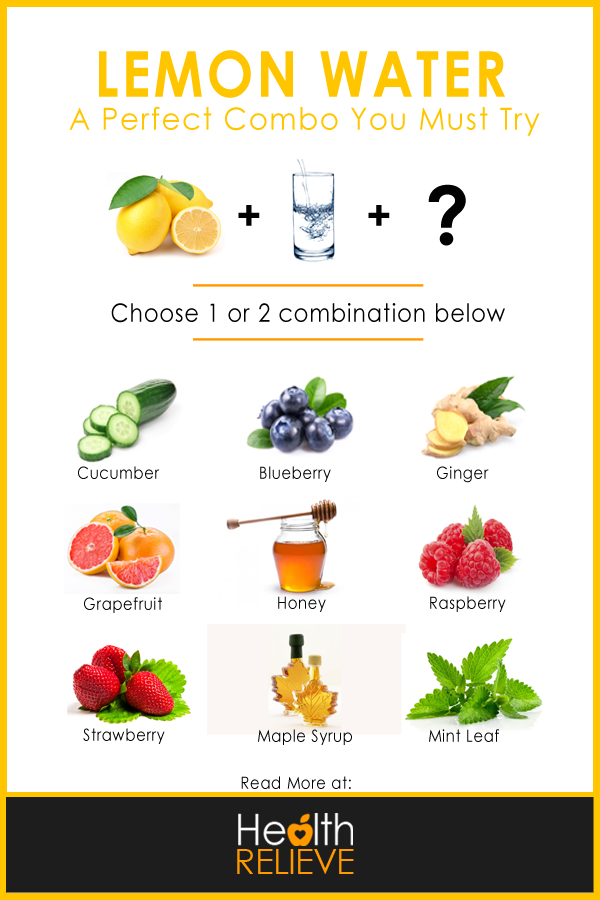
Say, for example, you weigh less than 150 pounds. This means that you’ll need to squeeze half a fresh lemon which is about an ounce into an 8 to 12 ounces of warm water. Weighing more than 150 pounds, you can have a whole lemon into a 24 to 32 of warm water. Drink it in the morning 30 minutes before meals.
Make sure the drink is warm or about room temperature to allow for full benefits of the lemon’s enzymatic properties. No salt or sugar should be added.
Make it a habit to drink lemon water in the morning to lower high blood pressure; however keep in mind that the formulation is not recommended for children under 12 years old to take daily.
6. Enhance your diet with special herbs
High blood pressure is frequently labeled as a form of medical ‘silent killer’ and eating foods that can contribute to this risk is like adding insult to the injury.
The typical diet today is rich in unhealthy elements, which actually have high cholesterol and sodium properties. This includes favorites like corn chips, French fries, and chicken wings you’re finding hard to resist.
Aside from these fatty acids, your intake of sugar, pizza, and junk foods can also cause high blood pressure. As discussed earlier, foods that have high sodium content can trigger increased fluid retention in your body.
So, what to eat instead?
To counter the effects of high cholesterol and sodium in your diet, you should look for natural herbs with validated antihypertensive therapeutic values. Garlic and celery are great examples of this.
Garlic Tincture Recipe
You need the following:
1 cup fresh garlic
2 cups vinegar
1 large mason jar
Steps:
1. Chop the garlic
Start by chopping the garlic using a food grinder, blender, or a mortar and pestle.
2. Place the chopped garlic in the glass jar
Place all the chopped garlic into the jar. Afterwards, put the prepared amount of vinegar into the jar. This will allow the extraction of medicinal properties from the garlic.
3. Seal the jar
Screw the lid of the jar tightly and label it with ‘garlic tincture’ along with the date of preparation.
4. Let it sit for 2 to 3 weeks
While waiting, make sure to shake the jar daily. The preparation date label will allow you to know when 2 or 3 weeks has passed.
5. Strain the garlic
After 2 to 3 weeks, strain the garlic from the vinegar. You can do this using a strainer or colander. Press the chopped garlic with a spoon against the strainer to make sure all the fluid is extracted out of the garlic before disposing.
6. Properly store the garlic tincture
Transfer the garlic tincture into a dark colored glass jar or simply place a dark covering to surround the glass jar. Store in a cool dry place. A dark and cool storage will allow the tincture to last for at least 1 year. More so, prolonged exposure to light can damage the tincture’s quality.
Dosage: Adults can take at least 5 drops daily.
Check out this amazing infographic of herbs that can help lower high blood pressure:
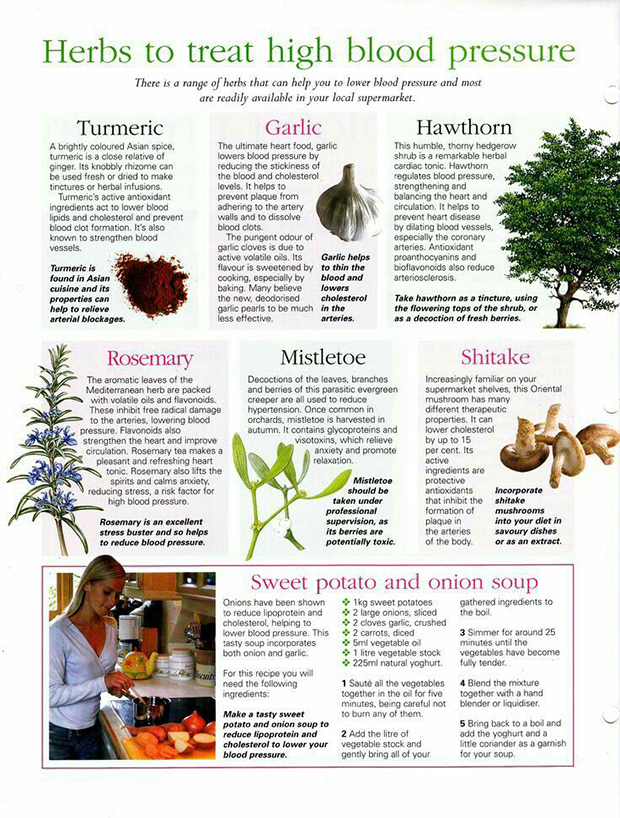
Adding probiotics to your diet is also an excellent idea.
Probiotics are friendly bacteria that mainly assist with digestive processes, and found to help lower high blood pressure.
- Your digestive system plays a major role in keeping you and your body healthy. It’s what prevents the pathogens or harmful substances you ingest from fully penetrating your system.
- If your gut’s health is impaired, unhealthy gut microbes cause an alteration in the regulation of hormones involved in controlling blood pressure. It will trigger fluid imbalance leading to a rise in blood pressure.
This is where probiotics enter the picture.
However, with quite a lot of strains, you should remember that not all probiotics are created equal. For your blood pressure, it still remains a need for further study to identify which probiotic strains are the best in reducing blood pressure.
Being able to consume multiple probiotic strains is found to be more effective than taking just a single probiotic bacteria strain. If you can find a food based probiotic supplement, even better!
When looking for a probiotic source, always consider how much live bacteria is present. The best source you can get includes raw and fermented foods.
Probiotics, when taken internally, line your gut to create a barrier to create a protective shield against bad bacteria. It may take you more than 8 weeks of regular probiotic intake to notice a reduction in blood pressure.
Fermented vegetables are an ultimate resource for probiotics.
7. Increase Omega-3 consumption
Contrary to what most people believe in, not all fats are bad for the body. In fact, there are fats that can actually help you lower high blood pressure.
Omega-3 fatty acids, specifically Docosahexaenoic Acid (DHA) and Eicosapentaenoic Acid (EPA), have diverse health promoting effects in protecting the nervous, immune, and cardiovascular system.
For control of blood pressure, DHA promotes critical vasodilatory influence by activating specific potassium channels that can control calcium ion influx and other calcium ion–dependent physiological processes. EPA, on the other hand, helps your body create the hormone eicosanoids which has blood thinning and anti-inflammatory properties.
If you suffer from hypertension, then increasing your intake of Omega-3 fatty acids can surely help. The bulk of published randomized controlled trial have shown that with regards to the efficacy of DHA and EPA, you’ll need about 3 grams a day to achieve best effect. If prefer a higher dose, you need to discuss it first with your doctor.
In case you are wondering how to get them, there are Omega-3 fatty acid supplements you can buy. For an all-natural approach, however, then your best option is oily fishes.
It will be helpful to be very careful in selecting your fish source because there are some types of fish that contain toxic levels of mercury.
To give you an idea of best sources, below is a list of fish types high in Omega-3 fatty acids but low in mercury content.
- Sardines
- Oysters
- Mackerel
- Salmons
- Trout
- Anchovies
In contrast, you have to limit your intake of king mackerel, marlin, and tuna for they have the highest level of mercury according to experts.
Besides fish sources, Omega-3 fatty acids can also be found in plant and nut oils. Great examples of sources include walnut, chia seeds, and flaxseed.

Credits: Dr. Axe
Consuming enough Omega-3 fatty acids can help you lower high blood pressure. However, consuming Omega-3 in supplement form should be taken with meals to minimize intestinal discomfort.
One gram of omega-3 is in about 3.5 ounces of fish.
8. Boost nutrient intake with green smoothies
A lot of individuals are taking interest in green smoothies. These drinks are healthy, quick to do and… green.
While the color can get you to cringe, green smoothies aren’t really that bad. As a matter of fact, they’re refreshing and delicious.
Drinking green smoothies is an effective way to boost vegetable and fruit content in your diet. And with the benefits you’ll get, I’m pretty sure you won’t get enough of it.
So here’s a rundown of the benefits of green smoothies:
- The chlorophyll content, a phytochemical that basically gives plants their green color and pigmentation, is rich in magnesium and anti-inflammatory properties.
- Green smoothies are also known to be a high volume low calorie, vitamin- and mineral-rich food, effective in weight loss.
- The vegetable and fruit content of green smoothie is mostly rich in dietary fiber and potassium, which means it can lower cholesterol level and balance the blood pressure-raising effects of sodium.
You can also add a combination of greens and colorful fruits to make the experience exciting.
Here’s a quick and easy recipe for any green smoothie beginner:
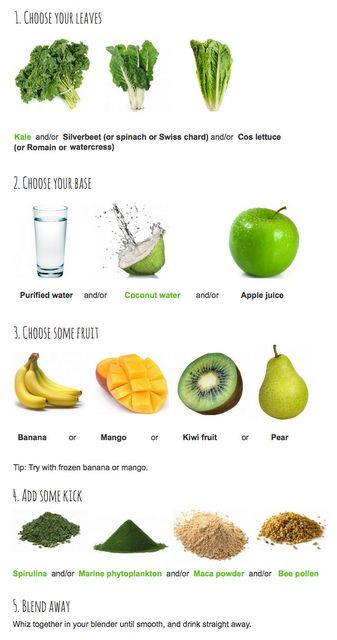
It’s best if you can consume your green smoothie as soon as you finish preparing it. If there are any leftovers, keep it in the freezer and enjoy the rest later.
Adding green smoothies to your diet can greatly improve your blood pressure and your health naturally.
However, be careful when adding sweets to your smoothies. Loading it with sugar can bring you weight gain over time which puts you at risk of increasing blood pressure instead of lowering it.
An 8-week daily consumption of 22 grams freeze-dried blueberry powder has also been found to reduce systolic and diastolic blood pressure by 5.1% and 6.3%, respectively. It will be an excellent ingredient to your smoothie.
9. Stay with high fiber foods
Contrary to what many people believe in, bulking up on dietary fiber is also important for your blood pressure. Besides, it can provide other health benefits including weight management and lowering your risk of heart disease and diabetes.
- Naturally, your body does not have the ability to digest or absorb fiber (also known as roughage). It is a part of plant foods that only passes through your stomach, small intestine, and colon then out of your body.
- High-fiber foods are more filling compared to low-fiber foods. This makes you eat less but satisfied. Having fewer calories for the same volume of food, it is very effective in assisting you lose weight, hence an indirect benefit in controlling blood pressure. It has also been found to lower total blood cholesterol levels by reducing low-density lipoprotein (“bad” cholesterol).
- In a 2000-strong INTERMAP study, higher intakes of fiber has been found to also have a direct contributory effect in lowering blood pressure independent of blood pressure lowering nutrients associated with fiber rich foods such as potassium content which is particularly true for insoluble fiber.
Giving your blood pressure all the help it needs is the best thing you can do at this point.
Let me present to you two classifications of dietary fiber:
1. Soluble Fiber
Soluble fiber also binds to sugar and cholesterol to slow their absorption into the blood to help regulate blood sugar levels and reduce blood cholesterol.
Good sources of soluble fiber include apples, citrus fruits, beans, peas, oats, barley, carrots, and psyllium.
Benefits include weight loss, diabetes protection, heart protection, and healthy bowel movements.
2. Insoluble Fiber
Insoluble fiber does not dissolve in water. It isn’t broken down and absorbed into the bloodstream.
Good sources of insoluble fiber include wheat bran, beans, nuts, whole-wheat flour, and vegetables such as green beans, potatoes, and cauliflower.
Benefits include weight loss and digestive health.
Which one is best?
Both soluble and insoluble fiber are your best options essential for a healthy diet and if you want to control high blood pressure. Here’s an interesting summary of comparison between the two:
| Soluble Fiber | Insoluble Fiber | |
|---|---|---|
| Texture | Gelatenous (jams) | Dry (wheat bran) |
| Mechanism of action | It has demulcent properties that protect the stomach (heartburn, gastritis) | It satisfies the appetite and has laxative effect (obesity) |
| Solubility | Dissolves in water | Does not dissolve in water |
| Best for | It helps reduce cholesterol and treat constipation | It helps reduce cholesterol |
| Found in | It is contained in vegetables, fruits, seaweeds, and legumes. | It is contained in seeds, nuts, and whole grains. |
One thing to keep in mind, however, whole foods is generally better than fiber supplements because these products don’t usually provide the variety of minerals, vitamins, and other healthy nutrients that food do.
Increasing fiber intake should be gradual over a period of a few weeks. Drinking water is also a good idea. These will allow the natural bacteria in your digestive system to make adjustments with your diet changes. It will help prevent any possible abdominal bloating, intestinal gas, and cramping that can happen with sudden, quick high-fiber intake.
An intervention period of at least eight weeks may be necessary to achieve a maximum reduction in blood pressure.
Oatmeal and oat bran are a great breakfast choice being high in fiber, low in fat, and low in sodium.
TO BE CONTINUED… so make sure to Bookmark this post now!



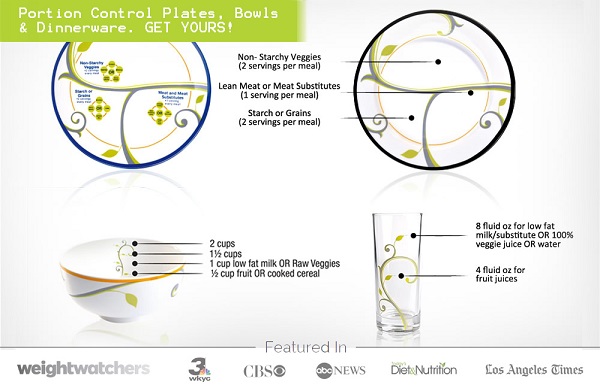
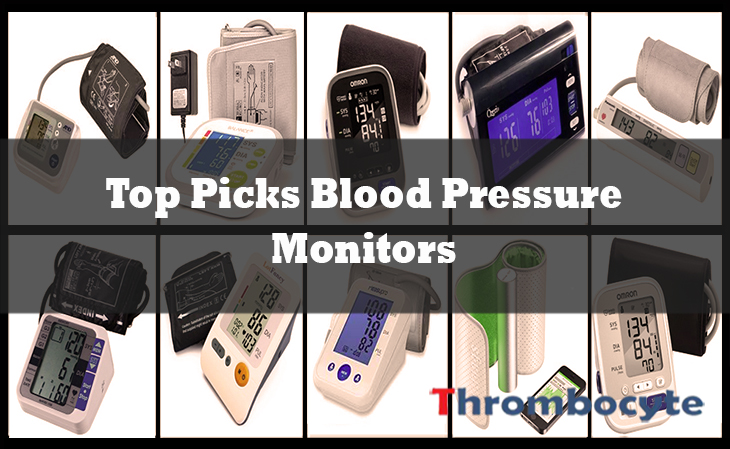
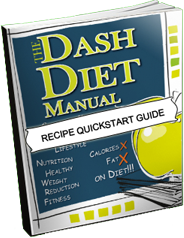

 We're committed to bringing you the best in health and helping you discover the wonderful world of the DASH diet. If you're looking to control your blood pressure, hypertension, or just looking to get into great health, we're here to help.
We're committed to bringing you the best in health and helping you discover the wonderful world of the DASH diet. If you're looking to control your blood pressure, hypertension, or just looking to get into great health, we're here to help. 



